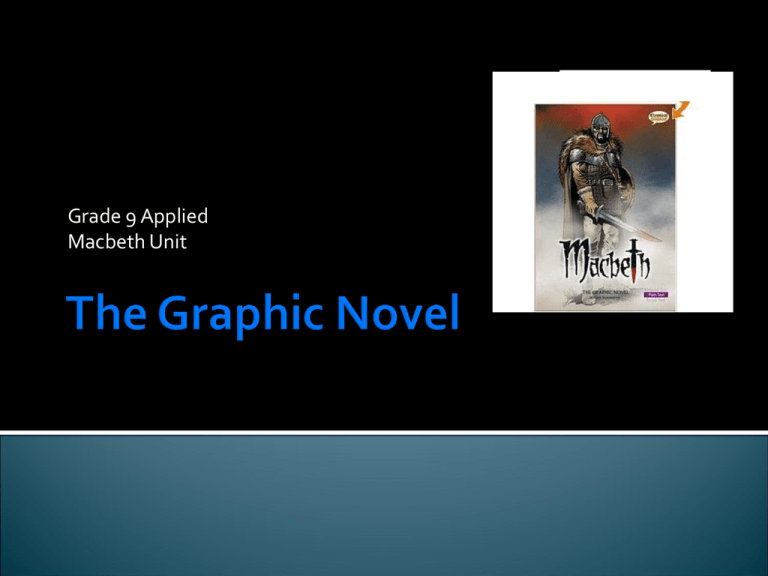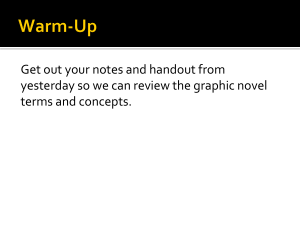Grade 9 Applied Macbeth Unit
advertisement

Grade 9 Applied Macbeth Unit Today, the graphic novel is the fastest growing literary genre in North America. A Graphic Novel is... A narrative (story) presented through text and pictures. Like a literary novel, the graphic novel may deal with a complex plot, diverse characters and settings, and a variety of subject matters (themes). Like text-only novels, graphic novels come in various genres, from superhero to romance, fantasy to science fiction, historical fiction and more. http://www.youtube.com/watch?v= 83H0nQvIbeA Let’s watch a video to learn more about graphic novels... Graphic Novels are... usually published in hardcover or as quality paperbacks. typically a higher quality than comic books in terms of the publication process. longer than comic books, sometimes running to hundreds of pages. Comic Books are... usually bound by staples. serialized on a monthly basis (or specified time period) with an episode of an ongoing story. usually not of book length. Barack and Spider-Man As a child, Barack Obama collected Marvel Comics. His favourite character was SpiderMan. Marvel Comics has decided to provide a commemorative comic book that has Spiderman saving Barak Obama, and the day. PANEL A box that contains the pictures showing what is happening in the story, and the dialogue of the characters. Panels literally frame the information in the story. Panels are arranged to flow in sequential order and help the reader quickly understand the gist of the story. Panels are arranged from left to right and then top to bottom. A graphic novel page is usually made up of multiple panels. Panels are the paragraphs we read in regular texts. WORD BALLOON The bubble-shaped spaces within a panel that contain dialogue or a character’s thoughts in textual format. The balloons may be singles or multiples, based on the length of the dialogue. Balloons come in a number of different shapes, each of which indicates a different sound level or mood. A fluffy cloud-shaped word balloon contains the thoughts of a character. Instead of a tail, a thought balloon usually has bubbles leading to the character who is thinking. The most common shape of the word balloon is oval. A balloon of this shape contains dialogue. CAPTION A caption box contains the narrative that fills in the details of the story being told. Captions add to the speech and artwork. They do not repeat what the artist has drawn. Their purpose is to fill in the gaps with the time and place of the action Usually a caption appears in a rectangular box at the top or bottom of a panel. GUTTER The space between panels on a page is called the gutter. PANEL BORDER A panel border is the box that encloses the actions of the scenes. Panel borders are not always the same shape; sometimes they are not used at all. FOCUS In depicting space or settings where the story unfolds in a panel, artists use methods similar to the ones used by movie directors. Zooming in...makes the subject bigger and more detailed (for example: closeup of a face) Zooming out ...drawing the picture relatively smaller and placing it in the background by means of a long shot. BODY LANGUAGE A character’s gestures and postures become powerful ways for communicating nonverbally with others and for telling stories. FACIAL EXPRESSION A character’s facial expression often reveals their feelings and sometimes their thoughts. MOVEMENT Movement is generated either while reading the dialogue in various types of balloons, or while following gestures, postures, actions, placement of various shapes, and picture elements. LIGHTING Lighting creates a crucial role in creating mood and feeling within the panels. For example, darkness creates a mysterious atmosphere in a panel. Lighting also communicates the time of day in which the action is taking place, for example, a moonlit night, or a sunrise, or midday in the desert. SOUND Sound is usually established through written words. Do you have any questions? Instructions: Each group of two will receive a page from a graphic novel that is missing word balloons. Envelopes with the missing word balloons will be provided. Together, you will place the captions and speech balloons in the panels, in an order that makes sense. Share your interpretations with another group. Calvin and Hobbes Task: Analyze the comic provided. You will notice the dialogue is missing. Look closely at the characters’ facial expressions and body language, as well as the setting and possible conflict Brainstorm a storyline that suits the images in each panel. Add text in the word balloons to make the comic complete. Tomorrow... Pre-reading activity Read Act 1 Balloons can express thoughts, dreams, speeches, loud voices, whisperings, wishes, sound effects, etc. Each student will be provided a handout with the same four panels from a graphic novel. The dialogue is already created, but the task is to incorporate different kinds of punctuation or different lettering styles and balloon shapes for effect. Experiment with the following: Capitalization Upper and lower case Jagged lettering All caps Emphasis on different words (e.g., bold, colour) Exclamation marks Dashes YOU SHOULDN’T HAVE EATEN THE WHOLE TOWN! YOU shouldn’t have eaten the whole town. But I was hungry. BUT I WAS HUNGRY. BURP.


